Westgrove
Houses within 10km of this house
Displaying 59 houses.
Houses within 10km of Westgrove
Displaying 59 houses.
| House name | Description | |
|---|---|---|
| Knocklofty | A mainly 18th century house, cited by Wilson as the seat of John Hely Hutchinson in 1786. In 1840 the Ordnance Survey Name Books describe it as "spacious and handsome, having a fine plain front". It was valued at £70 in the mid 19th century, the seat of the Earls of Donoughmore until 1983, though Walford mentions Samuel H. Goold-Adams of Knocklofty in 1885. The Irish Tourist Association surveyor writes that Knocklofty was De Valera's headquarters for a time during the Civil War. Until recently it served as a hotel but in 2013 it was offered for sale. |

|
| Lakefield (Middlethird) | Gambonstown was occupied by B.B. Bradshaw in 1814. In 1786 Wilson had referred to it as the seat of Mr. Hackett. The National Inventory of Architectural Heritage records the building of Lakefield house in 1831 by William Pennefather, replacing the former Hackett home of Gambonstown. and the Ordnance Survey Name Books record it as his residence in 1840. At the time of Griffith's Valuation William Pennefather held the house valued at £48.14 shillings and 413 acres from Mrs Hackett and others. Sold by the Pennefathers to the O'Briens in 1907 and sold again to the Goodbodys in 1955. Lakefield is still extant. |
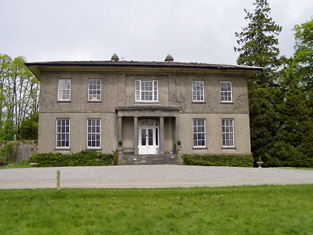
|
| Marlhill | This house was the residence of Robert Prendergast in 1814. In 1840 the Ordnance Survey Name Books also record it as his residence under the slightly variant name of Marlow Hill. James Prendergast held the house valued at £12.15 shillings from the Reverend John Bagnell with 182 acres in the mid 19th century [see Bagnell entry in ''Burkes Irish Family Records'']. Home of the Rice family from the 1860s. A building still stands at this site. | |
| Caher Park | Bence Jones writes that this house was built by Lady Margaret Charteris in the early 1860s to the design of Lanyon, Lynn and Lanyon. Valued at £45 in 1906, the house burnt down in the 1960s after being sold following the death of Lieutenant Colonel R.B. Charteris in 1961. Also known as Cahir Lodge. |
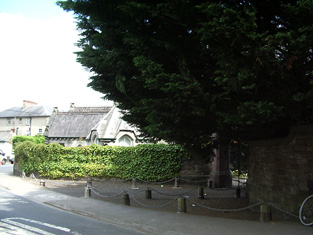
|
| Caher House | A house lived in by the Butler family when they ceased to use Caher Castle as a residence. Wilson mentions the seat of Lord Caher in the town. Located in the town square of Caher it now functions as a hotel. Leet records Lord Cahir as resident at Cahir Castle in 1814 but by 1837 Lewis writes that Cahir House was the seat of the Earl of Glengall. He held this house in fee at the time of Griffith's Valuation when it was valued at £100. |

|
| Mill View | This house was the home of the Sargent family in the 19th century, inhabited by Henry Sargent in 1814 and at the time of Griffith's Valuation. It was held from the Earl of Glengall and valued at £30 in the early 1850s. This house is no longer extant. | |
| Garnavilla | A branch of the Nagle family lived at Garnavilla in the 18th century. They held it on a lease from Lord Caher. James Archer Butler was the occupant of this house in 1837 and in the early 1850s when the house was valued at £21 and held from the Earl of Glengall. A building is still extant at this location. | |
| Ballybrada | The residence of Joseph William Fennell in 1814 and 1837. In 1840 the Ordnance Survey Name Books describe "Ballybrado House" as "old and plain, the residence of William Pnnyfeather". Thomas Fennell held the house and offices and 206 acres including a Quakers' graveyard from William Pennefather at the time of Griffith's Valuation. The buildings were valued at £21. The original house as marked on the first Ordnance Survey map is not extant now. The National Inventory of Architectural Heritage website features Ballybrada House built 1879, possibly by the Denny family. Charles E. Denny was resident in 1906 when the buildings were valued at £141+. |
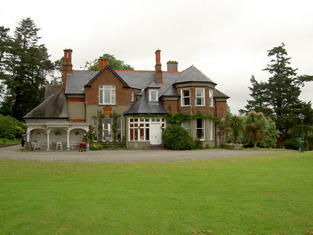
|
| Cottage (Caher) | The residence of George Fennell from 1814 until at least the mid 19th century, when it was valued at £22+ and held from Mrs Rachel Haughton. A building is still located at this site. | |
| Caherabbey House | Occupied by John Fennell in 1814 and by Richard Grubb in 1837. Montgomery records that Richard Grubb built a house at Cahirabbey circa 1833. Richard Grubb held the property in fee at the time of Griffith's Valuation when the buildings were valued at £70. He also had a flour mill closeby valued at £200. In 1894 Slater notes it as the seat of Rev. George Grubb. This house continues to be a family home. In 2013 it was offered for sale. |
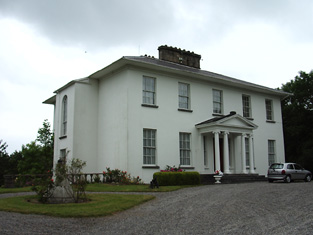
|
| Caherabbey House Upper | Joshua Fennell occupied a house known as Caher-abbey-villa in 1814 and in the early 1850s Joshua Fennell (Joseph) was occupying a house in Caherabbey Upper, valued at £29 and held from Ponsonby Barker. | |
| Alta Villa | The home of a branch of the Going family for much of the 19th century. Charles Going was resident in 1814, William Going in 1837. The Ordnance Survey Name Books describe it as "of modern structure in good repair" in 1840. William Going was also the occupier at the time of Griffith's Valuation when the house was valued at £22+ and his flour mill at £66. The property was held from the representatives of Dunbar Barton. Alexander Going of Alta Villa owned 313 acres in county Tipperary in the 1870s. Sir T. Warren lived at Alta Villa, Cahir in the mid 20th century. Alta Villa is still extant and occupied. |
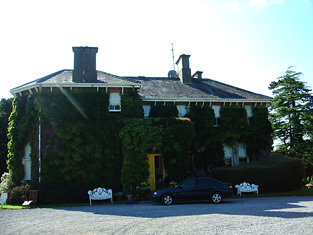
|
| Keylong | In 1786 Wilson refers to this house as the seat of Mr. Butler. Key-long was the residence of Richard Butler in 1814 and in the early 1850s Richard Carew was the occupier, holding the house valued at £12 from Thomas Going. This house is still a family residence. |
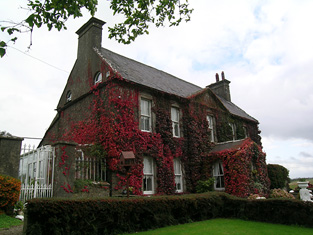
|
| Swiss Cottage | A thatched house built in a wooded area early in the 19th century and "probably designed by John Nash" (Bence Jones p.53). In the mid 19th century it was valued at £9 and held by the Earl of Glengall in fee. A lithograph of this building is included in the Glengall sale rental of November 1853 and the Burmester, Law and Sadlier sale rental of November 1857. Now in use as a heritage centre. |
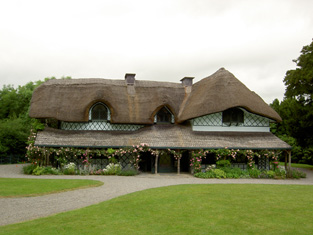
|
| Killemly Lodge | In 1837 the proprietor of Killemly Hall was H. Hughes but it was occupied by L. Clutterbuck. The Ordnance Survey Name Books also note it as his residence in 1840. The house was vacant in the early 1850s, valued at £9.15 shillings and held by Thomas Going from Mrs Catherine Sarsfield. There was a small corn mill nearby. A house is still extant at this location. | |
| Loughlohery | In 1786 Wilson refers to "Loughlokery" as the seat of Mr. Dogherty. The residence of William Quin from at least 1814 and held by him in fee in the early 1850s when the house was valued at £33. The Quinns were still resident at Loughloher in the 1870s. A house is still extant at the site. | |
| Coole | A house with a gatelodge marked on the first Ordnance Survey map and located just north of Knocklofty. Occupied by Thomas Morrissey in the mid 19th century, held from the Earl of Donoughmore and valued at £16+. A building is still extant at this location. | |
| New Abbey | In 1786 Wilson refers to New-Abbey as the seat of Moore Cootee. He notes that the house was close to "the great flour mills built by the late Stephen Moore". New-Abbey was occupied by Henry Moore in the mid 19th century and held from Stephen Moore, the buildings were valued at £11.16 shillings. | |
| Salisbury | Stephen Moore is recorded as resident here in 1814 and T. Sadlier in 1837. The christian name of the mother of Stephen Moore was Salisbury. By the time of Griffith's Valuation John Bagwell held the house in fee. It was valued at £18+. Percy Gough of Salisbury, Clonmel, owned 724 acres in King's County in the 1870s. Slater refers to "Inislonagh House" as the seat of Lt-Gen. Sir Charles J. Gough in 1894. Bence Jones writes that this house was leased to J.W. Cleeve in the early 20th century and from the late 1920s to Sir David O'Brien 6th Baronet. |

|
| Oaklands | William Ryal was living at Oakland, Clonmel, in 1814 and Mr Bagwell in 1837. Colonel Phipps was resident at the time of Griffith's Valuation, holding the house valued at £49.10 shillings from John Bagwell. Still occupied as a residence. |

|
| Woodrooff | The seat of the Perry family in the 18th and 19th centuries, Samuel Perry was resident in 1814 and William Perry in 1837 and at the time of Griffith's Valuation, when the buildings were valued at £66+. Samuel Perry was resident in 1906. Bence Jones writes that this house is now mostly demolished. | |
| Haywood | A house situated on the northern outskirts of the town of Clonmel, the home of Charles Riall in the first half of the 19th century. It appears to straddle the parish border between Rathronan and St Mary's Clonmel. The residence of John Riall in the 1870s. The site is now occupied by a shed. | |
| Shanballyard | Shanballyard House is marked on the first Ordnance Survey map. In the mid 19th century John Scully held buildings valued at £16+ and 299 acres from James Scully. The National Inventory of Architectural Heritage records this house as "disused". |
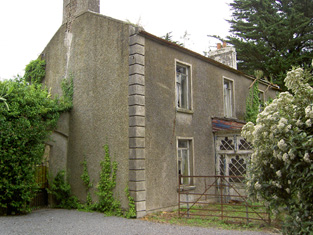
|
| Ballingarrane | Ballingarrane was originally leased and then purchased in the late 18th century by Solomon Watson, banker of Clonmel. He built Summerville House which later became known as Ballingarrane. W. H. Bradshaw occupied the house in 1837 and John Mulcahy in the mid 19th century when the buildings were valued at £25+ and held from Solomon Watson. The Watsons occupied the house again in the second half of the 19th century and family members were still resident in the late 20th century. |

|
| Glenconnor | This house also know as Larchfield was built by Solomon Watson at the end of the 18th century as a dower house for Summerville (Bence Jones). Leet records Larchfield as unoccupied in 1814. J. Bagwell was resident at Glenconnor in 1837 and Pierce Gough in the early 1850s when the house was valued at £23.10 shillings. Alderman William Byrne of Clonmel was resident here in the 1870s. Additions were made to the house in the 1880s and it was owned by a Colonel George Elliot in the early 20th century who sold it in 1938 to H.J.Cleeve. |

|
| Barn | The seat of the Moore family in the 18th, 19th and 20th centuries. In 1786 Wilson refers to it as the seat of Thomas Moore In 1840 the Ordnance Survey Letter Books note that it had "a garden nursery and ornamental ground". It was held by Stephen Moore in fee in the mid 19th century and valued at £49+. Randal K. Moore was resident in 1906 and Mr and Mrs Murray Moore in the early 1940s when the house contained a very fine library and antique art collection. Barn is still extant. |

|
| Knockeevan/Darling Hill | William Pennefather (died 1819) of Knockeevan was the second son of Richard Pennefather of New Park. Knockeevan became the home of his eldest son, Richard, Baron of the Exchequer, Ireland, who employed William Tinsley as architect in the mid 1820s. The house was originally known as Darling Hill and it belonged to the Carleton family in the 18th century. Wilson refers to it as the seat of Mr. Carleton in 1786. Oliver Carleton sold it to the Pennefathers in 1782. The house was held by the Honourable Baron Pennefather in fee at the time of Griffith's Valuation when it was valued at £54+. It later passed into the possession of Lady Emily Hankey, daughter-in-law of Baron Pennefather and then to the Stanhope family. Sold by the Stanhopes in the late 19th century or early 20th century. This house no longer exists. see http://www.dia.ie/architects/view/5338#tab_works concerning the architect. |
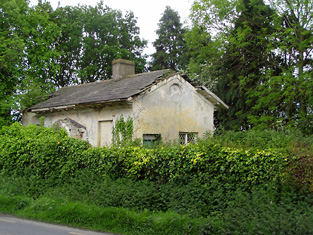
|
| Orchardstown | The home of the Hamerton family in the 19th century, occupied by John Hamerton in 1814. Mathew Hamerton was the occupier in the early 1850s holding the house from Major William M. Hamerton. The buildings were valued at £18+. | |
| Rathronan House | A property granted to John Walsh in 1679. Lewis describes this house as the "elegant residence of Major General Sir Hugh Gough". Viscount Gough was still resident in the mid 19th century when the buildings were valued at £47+ and held from Major William M. Hamerton. This property was in the possession of the Whalley family in the late 19th century. A house is still extant at the site. | |
| Melview | A house on the outskirts of Clonmel, occupied by Robert Malcomson in the mid 19th century, held from John Bagwell and valued at £52. This building now functions as a nursing home. |

|
| Rathduff | A house occupied by Thomas Kennedy and held from the Reverend John W. Hackett and partners in the mid 19th century when the buildings were valued at £16.15 shillings. | |
| Bird Hill | A house located on the outskirts of Clonmel town was the residence of a member of the Taylor family in 1837. At the time of Griffith's Valuation this house valued at £10.12 shillings was occupied by Margaret Cantwell and held from Stephen Moore with 7 acres of land. This house is still in use as a residence. | |
| Clonacody | The residence of John Hunt in 1814 but the Kelletts were resident by 1837. The Ordnance Survey Name Books refer to Clonacody as the seat of John D. Kellett. James Sadlier was the occupier in 1850 holding the house valued at £28+ from John Kellett. The sale rental of 1856 records James Sadlier as tenant under the Court of Chancery in a case Massey v Kellett. The Kellett family continued to live at Clonacody until the mid 20th century and the house is still extant. |
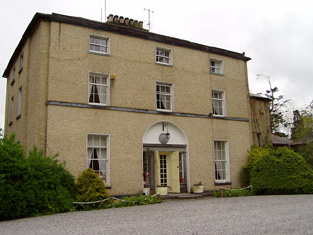
|
| Rockwell | Wilson refers to Rockwell as the seat of Andrew Roe in 1786. In 1814 and 1837 John Rowe/Roe was living at Rockwell. By the time of Griffith's Valuation John Bushe was the occupant, holding the property from the Court of Chancery. The buildings were valued at £40.16 shillings. John Bushe was the resident in May 1856 when the estate was advertised for sale. The buildings were altered and added too in 1865 after the arrival of the Holy Ghost Fathers who started a school. This school still operates as one of Ireland's well known boarding school. http://www.rockwellcollege.ie/missionstatement.html |
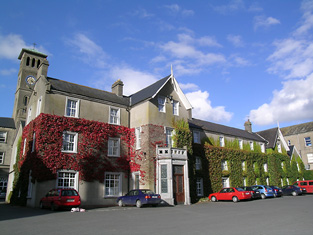
|
| Boytonrath | T. O'Meagher was the proprietor of Boytonrath in 1814. The Ordnance Survey Name Books refer to Richard Anderson as the occupant in 1840. In the early 1850s Henry Andrews was the occupier holding the property from the representatives of William Roe. The buildings were valued at £12+. A house and farm are still extant at the site. | |
| Lowesgreen | Lowesgreen was the home of Richard Butler Hamilton Lowe in the 1780s. By 1814 Benjamin Bradshaw was resident here and Mrs Hannah Carey was occupying the house in the mid 19th century when it was valued at £16+ and held from Robert [Richard] B. Lowe. The Newenham sale rental of 1865 records Solomon Watson as tenant and representative of Hamilton Lowe who had been granted a lease for lives renewable for ever from John Newenham in 1753. A house is still extant at this site. | |
| Donegal | John O'Halloran occupied Donegal House in the mid 19th century which he held from Arthur Riall. The buildings were valued at £12.18 shillings. This house no longer exists but a farm complex is still located at the site. | |
| Loughkent | Nicholas Dogherty is recorded as the occupier of Loughkent House in 1814 and in 1850, when he held the house valued at £12.18 shillings from Arthur Riall. It is no longer extant. | |
| Garranlea | A Keating home from the 18th century, occupied by Leonard Keating in the first half of the 19th century. In 1800 Leonard Keating married Lucinda Scully of Kilfeacle. Their son, Robert, was Member of Parliament for county Waterford in the late 1840s. In 1850 he held the property from the Earl of Clonmel and the buildings were valued at £34+. This house no longer exists. | |
| Marlhill | Edward O'Meagher was the occupier of Marlhill in 1814. The Ordnance Survey Name Books mention Marlhill as the residence of J. O'Meaghar in 1840. Thadeus O'Meagher was the occupier in 1850. Thadeus held the house and 120 acres from Stephen O'Meagher and the buildings were valued at £22+. Buildings still exist at this site. | |
| Woodinstown | Woodinstown was the home of a branch of the Carew family in the 18th and 19th centuries. Robert Carew was resident in the first half of the 19th century, holding the property in fee at the time of Griffith's Valuation when the buildings were valued at £16. This house is no longer extant. | |
| Garraun | In the early 1850 John O'Meagher occupied a steward's house at Garraun which he held from - Stratford. The buildings were valued at £12+. A farming enterprise is still located at this site. | |
| Maginstown | A house valued at £13+ in the townland of Maginstown was occupied by James O'Donnell at the time of Griffith's Valuation and held from William Fennell. Buildings are still located at this site. | |
| Ardsallagh | The home of George Gough in the first half of the 19th century. It is described in the Ordnance Survey Name Books in 1840 as "a gentleman's residence with garden's attached and surrounded with ornamental grounds". It was valued at £37.12 shillings in 1850 and held from George Fennel. In the 1870s Colonel George Frend of Ardsullagh owned 100 acres in county Tipperary. Still in use as a country house. |

|
| Derryluskan | The Pallisers were resident at Derryluskan from at least the mid 18th century. John Palliser was the proprietor in 1814 and Mrs Palliser in 1837. Their son Colonel Wray Palliser was the occupant at the time of Griffith's Valuation. He held the property from Colonel Gore and the buildings were valued at £45.17 shillings and held with a demesne of 682 acres. The Pallisers were still residing at Derryluskan in the 1870s. The house has been greatly reduced in size but still functions as a residence. |
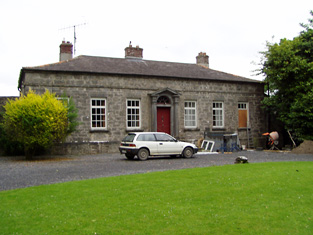
|
| Tullamain Castle | Tullamaine Castle was the home of John Power, father of the 1st Sir John Power, Baronet. Leet records J.D. Scully as resident at Tullaghmain-castle, Fethard, in 1814. This was James Scully (1779-1853), fourth son of Jeremiah Scully of Silverfort. By 1837 Lewis records John Maher as resident though the Ordnance Survey Name Books in 1840 refer to the proprietor as a Mr. Walsh. By the time of Griffith's Valuation Maher is recorded as holding the property in fee. The buildings were valued at £44.16s. By the mid 1870s Tullamaine Castle belonged to Henry Maynard Harding who advertised it for sale in July 1880. Slater still refers to it as his property in 1894. Dr M.J. Barry was resident at Tullamain in 1906. The castle was burnt in the early 1920s but rebuilt and is still a country residence. In the early 1940s C. A. Vigours was resident. |
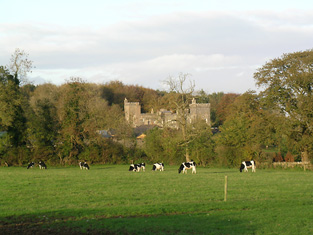
|
| Kilnamack | In 1849, the representatives of John Greene were leasing this property to Edward Butler when it was valued at £12 11s. Both Wilson and Taylor and Skinner had also recorded it as a residence of the Greene family in the 1780s. It is still extant and in 2013 was offered for sale. |
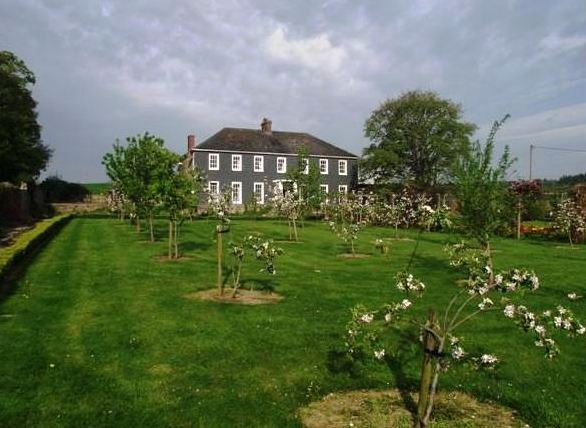
|
| Ballydrehid | In 1786 Wilson refers to Ballydrehid as a seat of Viscount Lismore, "pleasantly situated on rising ground". The home of Robert Keating in 1814 and of Robert Doherty in the early 1850s. Doherty held the property from Viscount Lismore and the house was valued at £17. This house is still extant and occupied. |

|
| Kilmanahan Castle | Robert Sparrow was leasing this property from the Greene estate in 1850 when it was valued at over £72. It was offered for sale as part of William Greene's estate in July and December 1852. The sale notice includes a lithograph of the castle. It was bought by Alexander Glasgow who sold it on to the Earl of Donoughmore in 1855. Earlier, in 1786, Wilson notes it as the seat of Mr. Greene. In 1837, Lewis refers to it as the seat of Lt. Col. Nuttall Greene. Hussey records Thomas Wright Watson of Kilmanahan Castle in the mid 1870s. In 1906 it was part of th Donoughmore estate and valued at £45. It is still extant. |
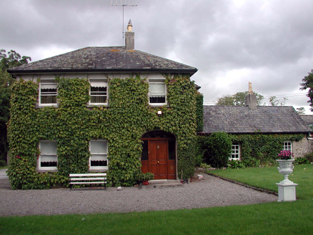
|
| Ballinattin | In 1786 Wilson refers to "Ballattin" as the seat of Mr. Parsons. This house valued at £17+ in the mid 19th century was occupied by Thomas Cooney and held from William Moore. A farm exists at the site and the original house is not extant. | |
| Ballinattin House | Occupied by Denis Cooney at the time of Griffith's Valuation, valued at £13+ and held from Edward B. Vise. This house is still extant and occupied. | |
| Little Island | This house was situated on an island in the Suir River in the southern part of Clonmel town. It was the home of the Morton family in the 19th century but is no longer extant. The Reverend James Morton held the house valued at £42 from his father Samuel at the time of Griffith's Valuation. | |
| Summerhill | Summer-hill, Clonmel, was the residence of the Reverend George Mills (sic) in 1814. The house was valued at £15+ in the mid 19th century, occupied by Mrs Dorothea Moore and held from the representatives of the Reverend Miles. In the 1870s Dorothea Moore of Dublin owned 288 acres and Henry Moore of Summerhill, Clonmel owned 247 acres in county Tipperary. Lewis refers to the handsome residence of R. Moore in 1837. |

|
| Redcity | In the mid 19th century William Harney held a house valued at £11+ from Sir John Power in the townland of Redcity. Buildings are still located at this site. | |
| Drangan | In the mid 19th century Daniel Heffernan held buildings valued at £15 from the Earl of Lismore at Drangan Beg. Drangan House is marked on both the first and 25-inch edition Ordnance Survey maps. A house and large farm are now located at the site. | |
| Cuckoo Hill | In 1786 Wilson referred to a house he called "Clover-Hill", three miles from Caher, "the seat of Mr. Ryall". He may have been referring to the townland named Cuckoohill which appears on the 1st edition Ordnance Map. A house is present in this townland which is labelled Cuckoo Hill House on the 25-inch Ordnance Survey map of the 1890s. At the time of Griffith's Valuation, this property was leased to Patrick Heffernan by Abraham Riall when it was valued at over £6. A house and farm still occupy the site. | |
| Chancellorstown House | In 1786 Wilson refers to Chancellors' Town as the seat of Mr. Moore. The house and surrounding demesne are shown on the first edition Ordnance Survey map but are not marked on the 25-inch edition of the 1890s. The townland was part of the estate of Stephen Moore at the time of Griffith's Valuation, though the house was leased by the representatives of Joseph Gough to Denis Daly and was valued at £7 10s. Farm buildings occupy the site now. | |
| Rosemount (Caher) | In 1840 the Ordnance Survey Name Books refer to Rosemount as a house in good repair, the residence of Robert Franklin. He is also listed as the occupier at the time of Griffith's Valuation, leasing from the Barton estate when the buildings had a valuation of £10. Robert Franklin of Rosemount is listed in Slater's Directory of 1846. The house is no longer extant. | |
| Hymenstown House | Hymenstown House is shown on the 25-inch Ordnance Survey map of the 1890s. The National Inventory of Architectural Heritage suggests it was built sometime in the 1860s. The house on the site at the time of Griffith's Valuation was owned by Nathaniel Robbins and valued at under £2. In 1901 it appears to have been the property of Alex Going but was vacant at the time. Hymenstown House is still extant and occupied. |
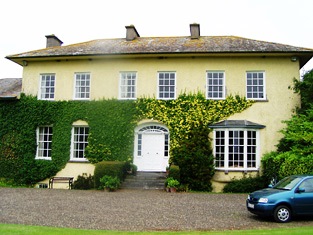
|

